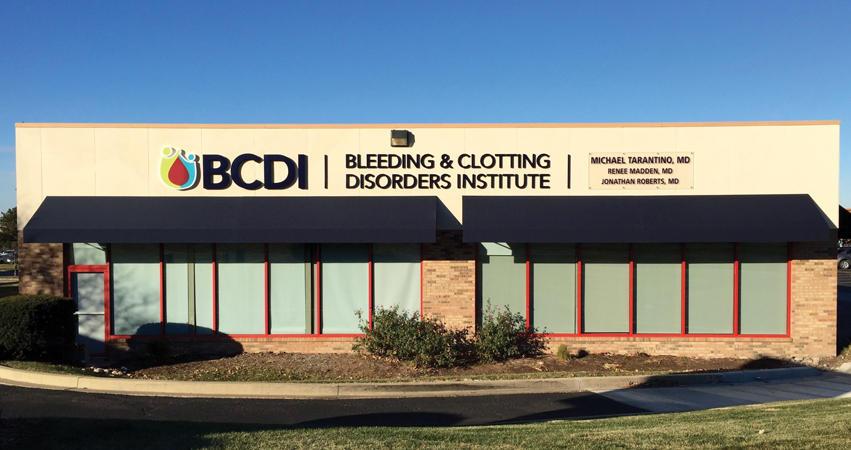
Increasing awareness and support for individuals living with a bleeding or clotting disorder
The U.S. Department of Health and Human Services recently approved the addition on its National Health Observances calendar of March being “Bleeding Disorders Awareness Month.” March is also observed as “Deep Vein Thrombosis Awareness Month” and “Blood Clot Awareness Month.” Throughout the month, the bleeding and clotting disorders community comes together to spread awareness and strengthen support for individuals living with a bleeding or clotting disorder and their families.
Blood flow in the human body is designed to be fluid and uninterrupted, delivering oxygen and other nutrients to all tissues. In their healthy state, blood cells and blood vessel linings have smooth surfaces to promote this. When a blood vessel is injured, the harmonious flow of blood is disturbed, and a clot is formed at the site of injury to restore streamlined flow. One can imagine this is a complex process, requiring a balance between the prevention of bleeding and excessive clotting. Many individuals have a disorder of this balance, and sometimes end up with excessive bleeding or clotting.
Bleeding Disorders and Treatment
Persons with bleeding disorders typically lack the ability to produce a firm clot, either because of a defect in blood platelets or blood clotting proteins. If any of the body’s 13 clotting factors is defective or deficient, blood clotting may be abnormal, and a bleeding disorder can result. Symptoms of a bleeding disorder include excessive nosebleeds; unexplained bruising; exaggerated bleeding after minor cuts, injuries, surgery or trauma; and prolonged or heavy menstrual periods. In addition, bleeding may be spontaneous, especially in those with severe disorders.
Some bleeding disorders, such as hemophilia, are inherited or acquired; others can occur from conditions like anemia, cirrhosis of the liver, HIV, leukemia and vitamin K deficiency. Disorders can also result from certain medications that thin the blood, including aspirin, heparin and warfarin. A common acquired bleeding disorder involving the platelets is immune thrombocytopenia (ITP). This is usually a temporary problem for children, but in some children and most adults who develop ITP, chronically low platelets are the result.
The treatment for bleeding disorders varies, depending on condition and severity. In some cases, clotting factor concentrates may be infused to replete the missing factor and prevent or treat bleeds. For other bleeding disorders, topical products or nasal sprays that augment good blood clotting may be useful. For more profound clotting factor deficiencies when a specific factor concentrate is not available, plasma from the blood bank may be necessary.
Clotting Disorders and Treatment
The development of a blood clot is called thrombosis. The vascular system includes both the venous system (which delivers blood from tissues to the heart) and the arterial system (which delivers blood from the heart to tissues), and thrombotic episodes may occur in either. Symptoms relate to the part of the vascular system in which they occur, the extent of the clot, and whether the clot breaks off and travels to another part of the body, or embolizes.
A clotting disorder occurs when there is an increased tendency for excessive clotting, known as thrombophilia. Some conditions are acquired and typically become more common with increasing age. Common medical conditions may increase one’s risk for excessive clotting, including obesity, cigarette smoking, high blood pressure, diabetes (type 1 or type 2), high cholesterol and the use of oral contraceptives.
Individuals with thrombophilia may receive medications that partially block the coagulation system. Some may be prescribed anticoagulants or blood thinners on a long-term or intermittent basis, depending on the underlying cause. Ideally, they should receive care from a multidisciplinary team of medical professionals within a single facility. Like hemophilia care and prevention services delivered through Hemophilia Treatment Centers (HTCs), integrated care may decrease the morbidity and mortality associated with thrombophilia.
In addition, there are different terms that further define thrombotic episodes, such as deep vein thrombosis (DVT), a blood clot that forms in one or more of the deep veins in your body, usually in the lower leg, thigh or pelvis. The condition is very common; approximately two million people experience a DVT each year in the United States, and nearly half of patients with deep vein clots experience long-term health consequences that adversely affect their quality of life and require millions of dollars of treatment. Symptoms of DVT include recent swelling of the limb, unexplained pain or tenderness, skin that may be warm to the touch, and redness of the skin. If you are experiencing these symptoms, seek medical help immediately.
Specialized Knowledge and Services
If an individual is experiencing symptoms related to bleeding or excessive clotting, it is important to consult a board-certified hematologist. Board certification involves sub-specialized training, rigorous testing and peer evaluation designed and administered by specialists in the specific area of medicine. This specialized knowledge assists in arriving at diagnosis, ongoing management of a disorder, and opportunities for patients to participate in funded programs or clinical research trials.
As a nonprofit, multidisciplinary evaluation, treatment and research facility, the Bleeding & Clotting Disorders Institute (BCDI) is a medical home for individuals with bleeding and clotting disorders. BCDI provides specialized healthcare services, education, advocacy and state-of-the-art research, with more than 250 years of combined experience in the field. iBi
Dr. Michael Tarantino is Medical Director of the Bleeding & Clotting Disorders Institute. For more information, visit thebloodexperts.com or call (309) 692-5337.

